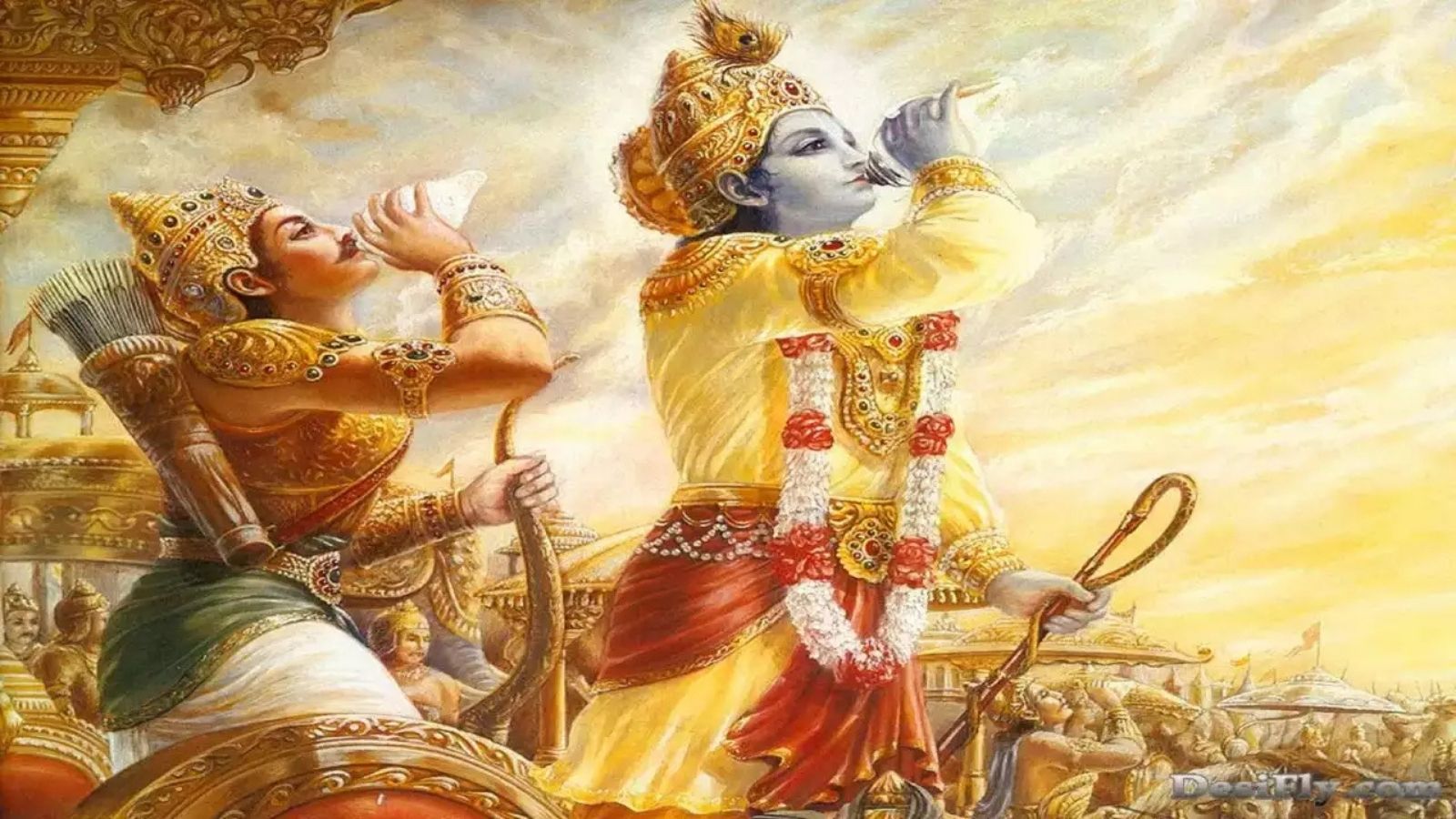From a series of talks by Sanjay Mehta,
transcribed and compiled by Jaya Asthana
Introduction and Summary
When we began this series of talks, some people asked, “there are so many talks and writings on Bhagvad Gita. What is the need for another one? What is the difference between this one and all the others?” The answer is that these talks are not different, because the message of the Gita is the same, it is relevant for all ages. The vehicle by which it is delivered is different, in the interpretation lies the difference.
These talks are geared towards children between the ages of 8 and 12, hence the language and examples are also directed at those ages.
Brief Summary
The Bhagvad Gita is a “Playbook for life, for all ages.”
Let us first understand the situation when and where the Bhagvad Gita takes place.
The Bhagvad Gita (Gita for short) takes place on the battlefield of the Mahabharat, where the armies of the Kauravs and Pandavs are lined up facing each other. In the center is Arjun in his chariot driven by Sri Krishna. Arjun, seeing his relatives, his Gurus, his revered Grandfather, feels afraid, and does not want to fight.
In Chapter 2 Arjun asks Sri Krishna, “what is my Swadharma, my personal duty?
Sri Krishna answers him by explaining about what “Shreyas” is: Shreyas is the greater good, what is good for all, not just for me and my close friends. When my Swadharma aligns with the greater good (Shreyas), then it becomes “nishkaam karma” (Karma without attachment).
In Chapter 6, Arjun asks about his mind, which is unstable, wandering all the time. Shri Krishna tells him about “abhyaas” and “vairaagya”. Abhyaas is practice. Vairagya is non-attachment to temporary objects. (Vairaagya can be split up as Raag=attachment, Vai= not attaching.) One must practice non-attachment to objects in life, since they are temporary.
At the end of the Geeta, after seeing Krishna’s “viraat roop”, his Divine form, Arjun says “my Moha (attachment) and my Sandeh (doubt) are gone, I can see clearly now.
“Yogah Karmasu Kaushalam”
Detachment to the results is the key to performing one’s actions skillfully.
Overview and Relevance
Before we begin our studies, we bow down and pay respect to our Gurus (our Teachers).
“Sadashiva Samarambham Shankaracharya Madhyamam
Asmad Acharya Paryantam Vande Guru Paramparam”
Beginning with Sadashiva, through Adi Shankaracharya in between and upto my own
Guru, I bow with reverence to the entire tradition of Guru’s
“Vasudēva sutaṃ dēvaṃ Kaṃsa Chāṇūra mardanam ।
Dēvakī paramānandaṃ Kṛṣṇaṃ vandē jagadgurum ॥
I worship Bhagwan Krishna, who is the son of Vasudeva,
Who killed Kamsa and Chanura, who is the bliss of Devaki.
For example, before going to Disneyworld, you have an image of the what the place will be like.
In the same way, we have an image or idea of what we are going to see or study. We shall see how much that idea that we have in our head aligns with what the Gita says.
There was a teacher called Madhusudan Saraswati ji, who composed one shloka that describes what Bhagvad Gita is.
Advaita-amrita varshineem bhagvateem ashtada shaadhyayineem,
Amba tvam anu sandadhaami bhagavad geete bhava dveshineem
Gita is that which was taught to Arjun by Bhagwan Narayan, Shri Krishna himself, which was composed by Rishi Ved Vyas in the middle if Mahabharat. It has 18 chapters. I meditate upon you, Mother Bhagwad Gita, who removes all past karma and destroys of all illusions of Samsara.
If we have any problems, we go to our Mother. In the same way, Bhagvad Gita is like our mother. We go to it for all solutions.
Arjun has Vishaad Rog, he was scared.
For example, you are walking on dark street, and you see some scary thing, you wonder, is it a ghost? You use your flashlight and see that it is just a pole or a post, there is no ghost, and the fear is gone. This confusion is called Vishaad (mental confusion, depression).
The first chapter is “Arjun Vishaad” (the confusion of Arjun.)
What action should you take if you are confused?
When you try to clear a doubt, you ask for someone to help you with it, maybe a teacher. Arjun had a teacher right with him, his teacher was his charioteer, Bhagwan Krishna.
In Chapter 2, Arjun said, “I am confused, should I go to the battlefield?” He wanted to run away.
We all do that, running away when we are fearful. Running away from Swadharma, which is our duty at this moment.
For example: if you see someone fall down on street, what is your duty? To help the person. For a student, your duty is to study. Arjun’s duty was to fight, to protect the people, since he was a prince. But he was running away from his Swadharma.
In the 7th shloka, chapter 2:
Karpanya dosopahata svabhavah
prcchami tvam dharma sammudha-cetah
yac chreyah syan niscitam bruhi tan me
sisyas te ‘ham sadhi mam tvam prapannam
Meaning…in short, Arjun says:
I am confused, my mind is puzzled with regard to my duty. I am not sure what my Swadharma is. Please tell me.
What is the meaning of Shreyas?
Meaning: That which is the greater good, which is good for ALL. Not what I like or dislike. I like ice cream, but is it good for me?
Arjun asks, What is good for me?
During Covid, the request from all authorities was to isolate, to wear a mask, so that we don’t spread the virus. That was the good of all of us, the greater good, that is “Shreyas”.
Arjun asks Bhagwan, what is Shreyas? Shreyas is What is good for all. What is my Swadharma, my duty right now?
Shreyas + swadharma= greatest good. The entire Bhagvad Gita is the answer to that.
Arjun was the student. What is the major quality of a student? To be humble, to listen, to trust your teacher. Use your learning in a good way. Surrender, drop your ego, only then learning takes place.
Steve Jobs, founder of Apple, used to say, “Stay Hungry (in your mind, not body), stay foolish”. If you say “I know, I know..” before you hear the teaching, you stop learning. Surrender to the teacher, then you will learn better.
Chapter 2, Shloka 47 is the summary of what Bhagwan is teaching Arjun:
Karmanye vadhikaraste Ma Phaleshu Kadachana,
Ma Karmaphala heturbhurma Te Sangostvakarmani
Meaning…
Your right is to work only, not to the fruits thereof. Do not be the cause of the fruit of the action.
Karma has three things: action, doer, and result. When doing Karma, we focus on the doer, “I am doing this”, and the result – “So I should get the result.” When performing Karma, what weakness do we have? We focus on the fruit (result) of Karma, the Karmaphal. Bhagwan says, focus on the action, not the fruit of the action.
Let us chant the Gayatri Mantra. This is a very powerful mantra. Say it slowly, there is no rush. Play the meaning in your mind.
Chanting Gayatri Mantra…
This is a mantra that is thousands of years old. It has not changed; it is a Perfect design. It has lot of power, which has been retained for thousands of years.
Meaning word by word: Gayatam Triyate iti Gayatri.
Why is it called Gayatri Mantra?
Gayatri is the meter in which this mantra is composed.
Gayatam = singing. Triyate = protection
Iti Gayatri. The one by chanting of which, I am protected. It protects the mind.
It starts with Om. Om is a sound, it is also the name of Bhagwan.
Definition: Avati iti OM.
Avati=protection. The one which protects is OM or Bhagwan.
Let us close with the closing Prarthana.
Om Puurnnam-Adah Puurnnam-Idam Puurnnaat Puurnnam Udacyate|
Puurnnasya Puurnnam-Aadaaya Puurnnam Eva vashissyate||
Om Shaantih Shaantih Shaantih||
Om, That (Outer World) is Purna (Full of Divine Consciousness);
This (Inner World) is also Purna (Full of Divine Consciousness); From Purna is manifested Purna (From the Fullness of Divine Consciousness the World is manifested),
Taking Purna from Purna, Purna indeed remains.
Om, Shanti, Shanti, Shantihi,



![[ India Today ] Ohio senator JD Vance thanks wife, a Hindu, for helping him find Christian faith](https://hinduvishwa.org/wp-content/uploads/2024/06/us-senator-jd-vance-reveals-how-his-hindu-wife-usha-helped-him-find-his-christian-faith-image-re-272530504-16x9_0-120x86.webp)










